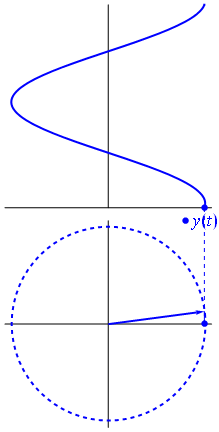I know that when the frequency is 0, the voltage will be pure DC. But in DSP and Digital Communication, I have seen mentioning of negative frequencies which I dont quite understand. For example, like \$ -f_{0}\$ to \$ f_{0}\$ frequency range. How could frequency become negative?
Electronic – Negative frequencies: what is that
frequency


Best Answer
The derivation of
\$cos(\omega t) = \frac{1}{2} \left(e^{j\omega t} + e^{-j\omega t}\right)\$
is all very nice and such (thanks, Mark), but it's not very intuitive.
A sine can be presented in the complex plane as a rotating vector:
You can see how the vector consists of a real and an imaginary part. But what you see when you watch the signal on your scope is a real signal, so how can you get rid of the imaginary part, such that the vector stays on the x-axis, increasing and decreasing? The solution is to add a mirror image of the rotating vector, rotating clockwise instead of counterclockwise.
The imaginary parts have the same magnitude, but opposite signs, so when you add both vectors the imaginary parts cancel each other, leaving a purely real signal.
If counterclockwise rotation stands for positive frequency, clockwise rotation has to stand for negative frequency.